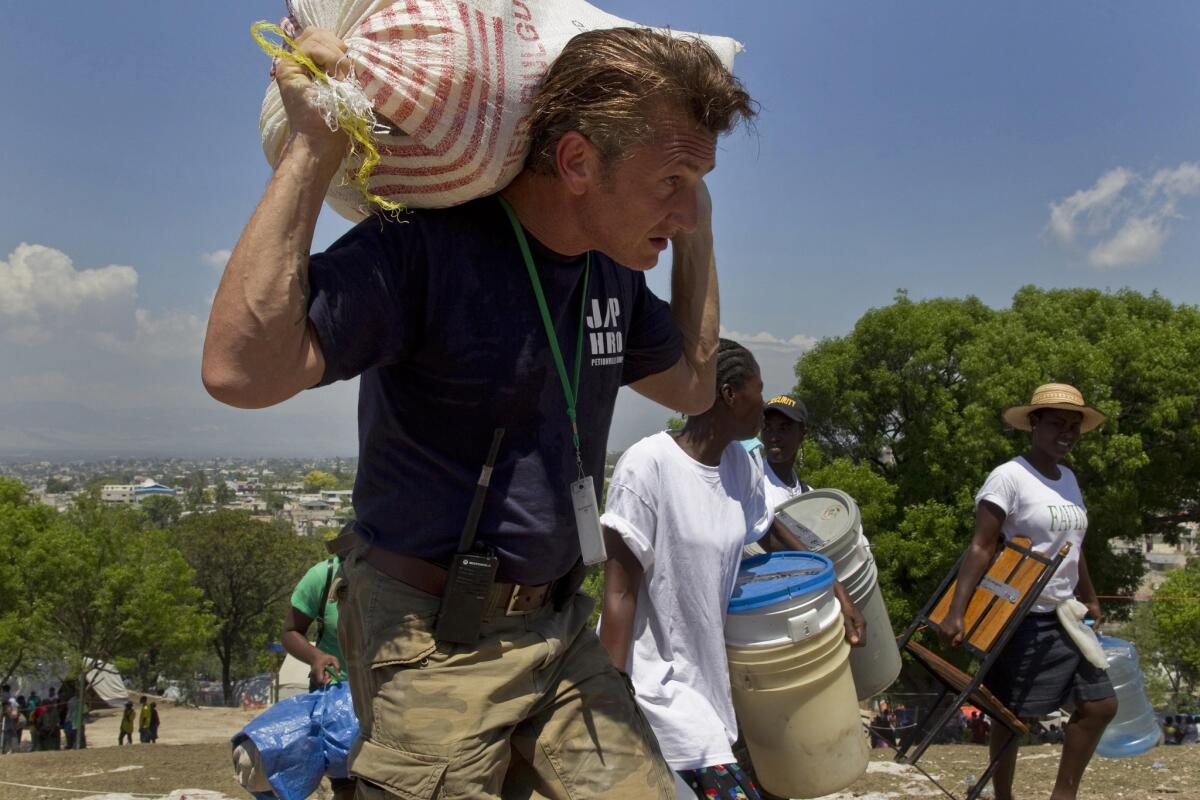Sean Penn’s hands-on aid for Haiti quake victims an earlier sign of his risk-taking

Sean Penn stayed in Haiti for months after the January 2010 earthquake.
- Share via
Three months after an earthquake destroyed much of the Haitian capital, a line of buses drove north into an arid waste of chalky dust.
The buses pulled up to a grid of dirt roads and a few white tents, flapping hard in the wind. Families began to spill out of the buses and look at their new homes, some in stoic resignation, some in despair.
These 62 people made up the vanguard of a larger plan to move much of the Haitian population from dangerous ravines and mountainsides around the devastated capital, Port-au-Prince, before the rainy season hit.
President Rene Preval greeted them at the camp, but he was not the man behind the move.
Sean Penn was.
Within days of the earthquake in January 2010, which killed more than 300,000 people and displaced 1.5 million, the Hollywood actor landed in Haiti and formed a relief organization, J/P HRO. Unlike other celebrities who dipped in and out, Penn stayed on the ground for months and has kept coming back.
Long before he made international headlines with this week’s publication of his clandestine jungle interview with the fugitive drug lord Joaquin “El Chapo” Guzman, Penn’s efforts in Haiti highlighted how he is prepared to take risks to become embroiled in some of the world’s larger human dramas.
Penn has shown he wants to be viewed as something more than a movie star and is not afraid to flout convention or draw controversy.
In Haiti, his celebrity cut through bureaucracy to help thousands of displaced people -- even if many now question some of the results.
“In some ways he did some good,” said Robert Fatton, a Haitian-born political science professor at the University of Virginia. “But there is also a certain resentment among Haitians that he represents himself as the only one that can save Haiti.”
At the steep Petionville Club golf course, a longtime haunt for American diplomats and businessmen next to the U.S. ambassador’s residence, Penn learned that an estimated 50,000 people who lost their homes were living in tents and lean-tos.
His group set about organizing the camp, digging drainage ditches, getting latrines, food and water. He lived and operated in an air-conditioned military-style tent – the size of a small office building – at the top of the hill by the club swimming pool.
The vision of Penn sleeping in a tent at a Haitian camp attracted reporters from around the world, and he quickly had one of the loudest voices on the ground in Haiti.
So when the rains began in a city that sprawls up a steep mountainside, he sounded the alarm that people needed to be moved.
Penn’s camp quickly became the focus of the media, the Haitian government and the United Nations mission in Haiti, even though there were hundreds of similar camps in similar danger.
And the massive relief effort evacuated the people at Penn’s camp first, sending them to the new camp, in a desert-like area called Corail-Cesselesse, before workers could prepare. U.S. military and diplomatic officials (and Penn) pushed to move people to this location against the wishes of Preval, whose government had all but collapsed with the earthquake.
Even some of those who volunteered to go questioned the move when they arrived. After she got off one of the buses, Romaine Vincent Donal, 44, walked across a dust-blown clearing looking for a latrine.
“I think they should have gotten things better organized before they brought us here,” she said. “The way they were explaining it, this place was going to be great. They lied.”
Preval awarded Penn a medal for his work in Haiti and his efforts to keep the country’s plight in the media spotlight.
Soon after that first move to Corail, Haitians began hearing rumors that they would receive free land in the region and that new factories would be built to provide jobs. Many flocked to the area, but the factories never materialized.
By September 2010, more than 40,000 squatters overwhelmed the 7,000 evacuees there, turning the vacant land into a new slum.
“There is a tremendous responsibility from the international community for creating this monster,” Jean-Christophe Adrian, country manager for the U.N. Human Settlements Program in Haiti, told the Miami Herald.
Adrian said Corail was an example of what happens “when Hollywood and the Pentagon get involved in humanitarian aid.”
“It doesn’t work,” he said.
More than 300,000 people now live in the Corail area, a chaotic place widely seen as one of the reconstruction efforts’ biggest failures.
Penn told the Herald that the U.N. mission and relief groups “forfeited on their obligations” to build a functional community there. “It’s sinful.”
Penn and his group remain active in Haiti. Preval’s successor named him “ambassador at large.”
For more news, follow @joemozingo.
More to Read
Sign up for Essential California
The most important California stories and recommendations in your inbox every morning.
You may occasionally receive promotional content from the Los Angeles Times.











